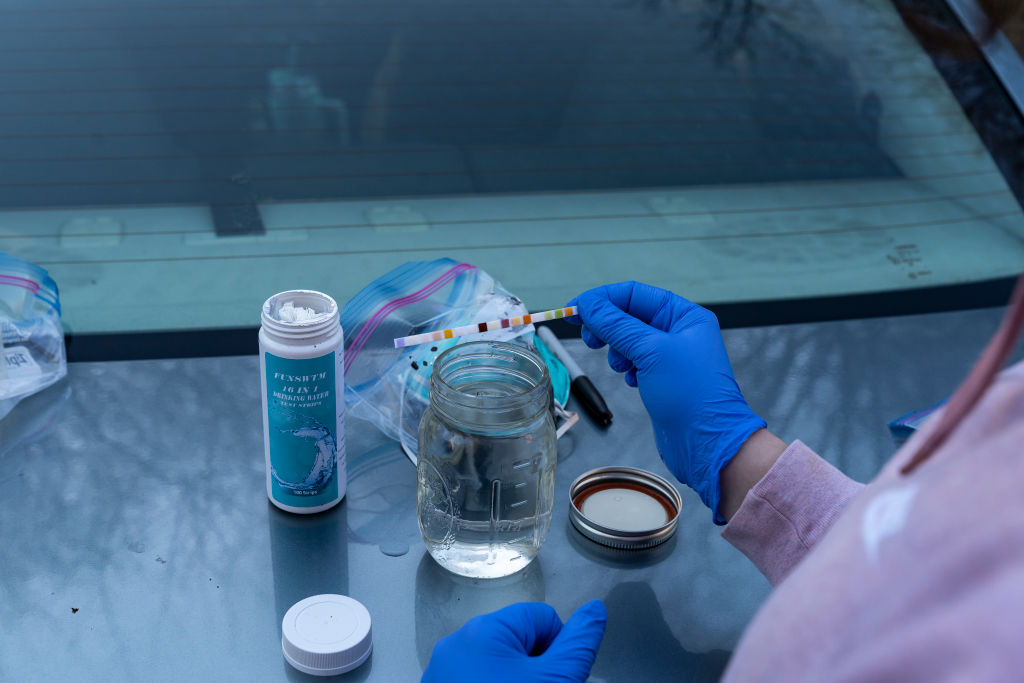
Three weeks after the Norfolk Southern train derailment and subsequent toxic chemical spill and fire in East Palestine, Ohio, a major grocery chain is pulling water that was bottled 25 miles from the crash site off of store shelves.
Giant Eagle, which operates hundreds of stores in five states, including Ohio, withdrew its spring water which comes from Salineville, Ohio, out of an “abundance of caution,” the company said in a Feb. 21 statement.
Giant Eagle’s move is the latest indication that the East Palestine spill is causing concerns far from the village of 4,700 people. Among the chemicals involved in the derailment was vinyl chloride, which the Centers for Disease Control and Prevention classifies as a carcinogen.
What Giant Eagle is saying
The grocery store chain noted that a third-party lab has been testing the facility’s water sources and bottled water samples. It did not find evidence that the water had been contaminated as a result of the Feb. 3 incident. But the company added that it would take the product off store shelves until further testing.
“As we continue to receive these assurances from our Salineville water vendor, we also recognize that regional and national health officials continue to send resources to East Palestine to learn as much as possible about the potential impact to the health of the community,” the grocery chain said. The water in these products comes from a protected spring which is located at a higher elevation than East Palestine, and therefore far from affected groundwater sources, it added.
Is contamination likely?
Experts say that it’s highly unlikely that water so far away from the site of the accident would be contaminated, especially so quickly. “I see that as sort of an irrational fear of the unknown,” says Murray McBride, an expert on soil contamination and emeritus professor at Cornell University.
James Connors, a licensed geoscientist and expert in groundwater contamination who has testified as an expert witness in dozens of court cases, notes that it’s unlikely for contamination in groundwater to travel 25 miles. He is familiar with cases in which contamination may travel up to six miles but notes those are usually the result of decades-long problems.
While acknowledging that the risk of contamination to Giant Eagle’s bottled water is very low, he says the company’s decision to pull the product until further information is commendable.
“They say it’s out of an abundance of caution. I would say that’s an accurate statement—and good for them; it’s not every company that takes profit off the table and does a more thorough evaluation,” Connors says.
Officials say water is safe
The Environmental Protection Agency has said that East Palestine’s air and drinking water is safe and that it will continue monitoring the effects of the toxic train derailment. However, some local residents have reported symptoms of dizziness, headaches, and rashes, resulting in concern that contamination is not being adequately measured.
In an effort to maintain calm, local, state, and federal officials have taken part in photo ops drinking water to assure residents it is safe. However, experts note that drinking one glass of contaminated water may not have the same effect as consuming it every day.
Although McBride believes the spring water from Salineville is safe, there is certainly a chance that local wells within a mile or so of the spill site may be affected. He says they will require regular water testing.
“We’re really just at the very beginning of that very long and very standard process,” Connors says. Until samples can be collected over a longer time range, “it’s very hard to come up with any reliable science-based conclusions about what the broader environmental impact is.”
Another complication: As a result of firefighters dousing the fires from the derailment, a lot of water has been introduced into the New Palestine environment. “That usually spreads the problem,” Connors says. “So what we do know is that there is a very high probability of groundwater contamination that will be significant, and probably will take years to clean up.”
Some of the toxic chemicals could move beyond the one-mile radius from the spill site over several years, and they could contaminate drinking water, as well as water used for farm animals, McBride says.
“It’s better to be safe than sorry. It’s better to be overcautious than under cautious. But I think I think this is a case of being a little too overcautious,” McBride says.
Conners, however, said in this case there’s no real downside to being overcautious.
More Must-Reads From TIME
- The 100 Most Influential People of 2024
- Coco Gauff Is Playing for Herself Now
- Scenes From Pro-Palestinian Encampments Across U.S. Universities
- 6 Compliments That Land Every Time
- If You're Dating Right Now , You're Brave: Column
- The AI That Could Heal a Divided Internet
- Fallout Is a Brilliant Model for the Future of Video Game Adaptations
- Want Weekly Recs on What to Watch, Read, and More? Sign Up for Worth Your Time
Write to Sanya Mansoor at sanya.mansoor@time.com